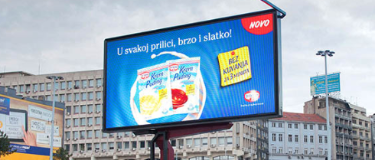News
Site Editor
 Site
https://hscled.cn08.wondercdn.com/uploads/image/68931a3c33409.png
In the heat of summer, not only us, but also electrical equipment must have a reasonable heat dissipation method. So, what are the characteristics of outdoor LED screens? How to properly dissipate heat for outdoor LED displays?
Site
https://hscled.cn08.wondercdn.com/uploads/image/68931a3c33409.png
In the heat of summer, not only us, but also electrical equipment must have a reasonable heat dissipation method. So, what are the characteristics of outdoor LED screens? How to properly dissipate heat for outdoor LED displays?
How to Properly Dissipate Heat for Outdoor LED Displays?
Views: 3233
Author: Site Editor
Publish Time: 2023-02-22
Origin: Site
LED display screen is an essential supporting artifact for modern sports venues, and it shoulders important functions such as game status display, score display, and sponsorship display in competitions. The LED display screens provided by Chinese suppliers will appear in the 2022 Qatar World Cup with consistent international first-class standards, creating a perfect presentation effect for top sports events and establishing a communication bridge for major international brands and fans.
Although there are more LED display companies that did not appear in the 2022 Qatar World Cup, they have helped the 2022 Qatar World Cup in their own way.
In the heat of summer, not only us, but also electrical equipment must have a reasonable heat dissipation method. So, what are the characteristics of outdoor LED screens? How to properly dissipate heat for outdoor LED displays?

1. Axial flow fan:
When installing the LED electronic screen, it is recommended to install an axial flow fan on the upper and both sides of the LED screen under this condition to extract the heat inside the screen, thereby prolonging the service life of the LED display. This method is frequently used in LED manufacturers.
2. Heat dissipation fins:
The most commonly used heat dissipation method is to use heat dissipation fins as the external material to increase the heating area and achieve the heat dissipation effect.
3. Aerodynamics:
Using the lamp housing to create convective air is the lowest cost cooling method.
4. Surface radiation heat dissipation treatment:
The surface of the LED display lamp shell is treated with radiation heat dissipation. It is relatively simple to apply radiant heat dissipation paint, which can radiate away the heat from the surface of the lamp housing.
5. Heat conduction and thermal integration
The purpose of using high thermal conductivity ceramic lamp housing to dissipate heat is to reduce the operating temperature of the LED electronic screen chip, because LED chips often have very different metal thermal conductivity, thermal expansion coefficient and material expansion coefficient, which cannot directly cause chip Soldering, to avoid high temperature and low temperature thermal stress damage chip LED electronic screen.
6. Heat pipe heat dissipation:
This is to use heat pipe technology to transfer part of the heat from the LED display chip to the corresponding heat dissipation exterior of the shell.
7. Thermally conductive plastic shell:
Fill the plastic shell with thermally conductive materials during injection molding to enhance the heat conduction and heat dissipation capabilities of the plastic shell.
With the maturity and innovation of technology and the strengthening of the concept of environmental protection, LED display manufacturers have continuously optimized the power, usage scenarios, heat dissipation and materials of the display to ensure that the screen can be more environmentally friendly and durable, and improve the viewing experience of users.
Want to learn more about outdoor LED Displays
Hope the above solution can help you solve the problem you encountered. HSCLED is a professional led display manufacturer, we provide all kinds of display, display rental, display solutions all over the world. If you want to know more, please contact us.









